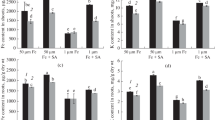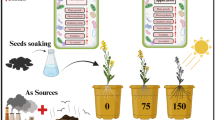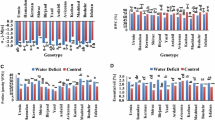Abstract
Peanut is mostly grown in calcareous soils with high pH which are deficient in available iron (Fe2+) for plant uptake causing iron deficiency chlorosis (IDC). The most pertinent solution is to identify efficient genotypes showing tolerance to limited Fe availability in the soil. A field screening of 40 advanced breeding lines of peanut using NRCG 7472 and ICGV 86031 as IDC susceptible and tolerant checks, respectively, was envisaged for four years. PBS 22040 and 29,192 exhibited maximum tolerance while PBS 12215 and 12,185 were most susceptible. PBS 22040 accumulated maximum seed resveratrol (5.8 ± 0.08 ppm), ferulic acid (378.6 ± 0.31 ppm) and Fe (45.59 ± 0.41 ppm) content. Enhanced chlorophyll retention (8.72–9.50 µg ml−1), carotenoid accumulation (1.96–2.08 µg ml−1), and antioxidant enzyme activity (APX: 35.9–103.9%; POX: 51- 145%) reduced the MDA accumulation (5.61–9.11 µM cm−1) in tolerant lines. The overexpression of Fe transporters IRT1, ZIP5, YSL3 was recorded to the tune of 2.3–9.54; 1.45–3.7; 2.20–2.32- folds respectively in PBS 22040 and 29,192, over NRCG 7472. PBS 22040 recorded the maximum pod yield (282 ± 4.6 g/row), hundred kernel weight (55 ± 0.7 g) and number of pods per three plants (54 ± 1.7). The study thus reports new insights into the roles of resveratrol, ferulic acid and differential antioxidant enzyme activities in imparting IDC tolerance. PBS 22040, being the best performing line, can be the potent source of IDC tolerance for introgression in high yielding but susceptible genotypes under similar edaphic conditions.








Similar content being viewed by others
References
Arnon DI (1949) Copper enzymes in isolated chloroplasts polyphenoloxidase in Beta vulgaris. Plant Physiol 24:1–15
Asada K (1999) The water-water cycle in chloroplasts: scavenging of active oxygen and dissipation of excess photons. Annu Rev Plant Physiol Plant Mol Biol 50:601–639
Boodi IH, Pattanashetti SK, Biradar BD (2015) Identification of groundnut genotypes resistant to iron deficiency chlorosis. Karnataka J Agric Sci 28(3):406–408
Boodi IH, Pattanashetti SK, Biradar BD, Naidu GK, Chimmad VP, Kanatti A, Kumar V, Debnath MK (2016) Morpho-physiological parameters associated with Iron deficiency chlorosis resistance and their effect on yield and its related traits in groundnut. J Crop Sci Biotechol 19(2):177–187
Castillo FI, Penel I, Greppin H (1984) Peroxidase release induced by ozone in Sedum album leaves. Plant Physiol 74:846–851
Chen C, Cao Q, Jiang Q, Li J, Yu R, Shi G (2019) Comparative transcriptome analysis reveals gene network regulating cadmium uptake and translocation in peanut roots under iron deficiency. BMC Plant Biol 19:35. https://doi.org/10.1186/s12870-019-1654-9
Dasgan HY, Ozturk L, Abak K, Cakmak I (2003) Activities of Iron-containing enzymes in leaves of two tomato genotypes differing in their resistance to Fe chlorosis. J Plant Nutr 26:10–11
Ding H, Duan L, Wu H, Yang R, Ling H, Li WX, Zhang F (2009) Regulation of AhFRO1, an Fe (III)-chelate reductase of peanut, during iron deficiency stress and intercropping with maize. Physiol Plantr 136(3):274–283
Fajardo JE, Waniska RD, Cuero RG, Pettit RE (1995) Phenolic compounds in peanut seeds: enhanced elicitation by chitosan and effects on growth and aflatoxin B1 production by Aspergillus flavus. Food Biotechnol 9:59–78
Forgy EW (1965) Cluster analysis of multivariate data: efficiency vs interpretability of classifications. Biometrics 21:768–769
Geulein I (2010) Antioxidant properties of resveratrol: a structure activity insight. Innov Food Sci Emerg Technol 11:210–218
Heath RL, Packer L (1968) Photoperoxidation in isolated chloroplast. I. Kinetics and stoichiometry of fatty acid peroxidation. Arch Biochem Biophys 125:189–198
Hiscox JD, Israelstam GF (1979) A method for extraction of chloroplast from leaf tissue without maceration. Can J Bot 57:1332–1334
Imenšek N, Sem V, Kolar M, Ivančič A, Kristl J (2021) The Distribution of minerals in crucial plant parts of various elderberry (Sambucus spp.) interspecific hybrids. Plants 10:653. https://doi.org/10.3390/plants10040653
Irmak S, Cil AN, Yücel H, Kaya Z (2012) The effects of iron application to soil and foliarly on agronomic properties and yield of peanut (Arachis hypogaea). J Food Agric Env 10(3/4):417–442
Kannan S (1982) Genotypic differences in iron uptake utilization in some crop cultivars. J Plant Nutri 5:531–542
Kong J, Dong Y, Song Y et al (2016) Role of exogenous nitric oxide in alleviating iron deficiency stress of peanut seedlings (Arachis hypogaea L.). J Plant Growth Regul 35:31–43
Kong J, Dong Y, Xu L, Liu S, Bai X (2014) Role of exogenous nitric oxide in alleviating iron deficiency-induced peanut chlorosis on calcareous soil. J Plant Interact 9(1):450–459
Kumar A, Kaur G, Singh P, Meena V, Sharma S, Tiwari M, Bauer P, Pandey AK (2022) Strategies and bottlenecks in hexaploid wheat to mobilize soil iron to grains. Front Plant Sci 13:863849. https://doi.org/10.3389/fpls.2022.863849
Lichtenthaler HK, Wellburn WR (1983) Determination of total carotenoids and chlorophylls a and b of leaf extracts in different solvents. Biochem Soc Trans 11:591–592
Livak KJ, Schmittgen TD (2001) Analysis of relative gene expression data using real-time quantitative PCR and the 2 (-Delta DeltaC (T)). Method Methods 25:402–408
Lopez-Millan AF, Grusak MA, Abadia J (2012) Carboxylate metabolism changes induced by Fe deficiency in Barley, a strategy II plant species. J Plant Physiol 169:1121–1124
MacQueen J (1967) Some methods for classification and analysis of multivariate observations. In: Le Cam LM, Neyman J (eds) Proceedings of the fifth Berkeley symposium on mathematical statistics and probability, 1:281–297. University of California Press, Berkeley
Mahatma MK, Thawait LK, Jadon KS, Rathod KJ, Sodha KH, Bishi SK, Thirumalaisamy PP, Golakiya BA (2019) Distinguish metabolic profiles and defense enzymes in Alternaria leaf blight resistant and susceptible genotypes of groundnut. Physiol Mol Biol Plants 25(6):1395–1405
Mann A, Singh AL, Kumar A, Parvender OS, Goswami N, Chaudhari V, Patel CB, Zala PV (2018) Exploiting genetic Variation for lime-induced iron-deficiency chlorosis in groundnut (Arachis hypogaea). Indian J Agric Sci 88(3):482–488
Nakano Y, Asada K (1981) Hydrogen peroxide is scavenged by ascorbate specific peroxidase in spinach chloroplasts. Plant Cell Physiol 22:867–880
Toomer OT (2017) Nutritional chemistry of the peanut (Arachis hypogaea). Crit Rev Food Sci Nutr. https://doi.org/10.1080/10408398.2017.1339015
Oustric J, Herbette S, Morillon R, Giannettini J, Berti L, Santini J (2021) Influence of rootstock genotype and ploidy level on common clementine (Citrus clementina Hort. ex Tan) tolerance to nutrient deficiency. Front Plant Sci 12:634237. https://doi.org/10.3389/fpls.2021.634237
Pattanashetti SK, Pandey MK, Naidu GK, Vishwakarma MK, Singh OK, Shasidhar Y, Boodi IH, Biradar BD, Das RR, Rathore A, Varshney RK (2020) Identification of quantitative trait loci associated with iron deficiency chlorosis resistance in groundnut (Arachis hypogaea). Plant Breed 139:790–803
Pattanashetti SK, Naidu GK, Prakyath KKV, Singh OK, Biradar BD (2018) Identification of iron deficiency chlorosis tolerant sources from mini-core collection of groundnut (Arachis hypogaea L.). Plant Genet Resour. https://doi.org/10.1017/S1479262117000326
Ranieri A, Castagna A, Baldan B, Soldatini GF (2001) Iron deficiency differently affects peroxidase isoforms in sunflower. J Expt Bot 52(354):25–35
Rebecca TV, Benoit L, Seung YR, Laurent N, Hatem R (2022) Mineral nutrient signaling controls photosynthesis: focus on iron deficiency-induced chlorosis. Trends Plant Sci. https://doi.org/10.1016/j.tplants.2021.11.005
Rudolf JL, Resurreccion AVA (2006) Elicitation of resveratrol in peanut kernels by application of abiotic stresses. J Agric Food Chem 53:10186–10192
Samdur MY, Mathur RK, Manivel P, Singh AL, Bandyopadhyay A, Chikani BM (1999) Screening of some advanced breeding lines of groundnut (Arachis hypogaea) for tolerance of lime-induced iron-deficiency chlorosis. Indian J Agric Sci 69(10):722–725
Samdur MY, Singh AL, Mathur RK, Manivel P, Chikani BM, Gor HK, Khan MA (2000) Field evaluation of Chlorophyll meter for screening groundnut (Arachis hypogaea L.) genotypes tolerant of iron-deficiency chlorosis. Curr Sci 79(2):211–214
Santos CS, Ozgur R, Uzilday B, Turkan I, Roriz M, Rangel AOSS, Carvalho SMP, Vasconcelos MW (2019) Understanding the role of the antioxidant system and the tetrapyrrole cycle in iron deficiency chlorosis. Plants 8(9):348. https://doi.org/10.3390/plants8090348
Schmidt W, Thomine S, Buckhout TJ (2020) Editorial: iron nutrition and interactions in plants. Front Plant Sci 10:1670. https://doi.org/10.3389/fpls.2019.01670
Singh AL, Chaudhari V (1993) Screening of groundnut germplasm collection and selection of genotypes tolerant to lime-induced iron chlorosis. J Agric Sci (camb) 121:205–211
Singh AL, Basu MS, Singh NB (2004) Mineral disorders of groundnut. National Research Center for groundnut (ICAR), Junagadh, p 85
Sperotto RA, Boff T, Duarte GL, Fett JP (2008) Increased senescence-associated gene expression and lipid peroxidation induced by iron efficiency in rice roots. Plant Cell Rep 27:183–195
Su Y, Zhang Z, Su G, Liu J, Liu C, Shi G (2015) Genotypic differences in spectral and photosynthetic response of peanut to iron deficiency. J Plant Nutr 38(1):145–160
Sun B, Jing Y, Chen K, Song L, Chen F, Zhang L (2007) Protective effect of nitric oxide on iron deficiency-induced oxidative stress in maize (Zea mays). J Plant Physiol 164:536–543
Vasconcelos MW, Grusak MA (2014) Morpho-physiological parameters affecting iron deficiency chlorosis in soybean (Glycine max L.). Plant Soil 374:161–172
Verma A, Mahatma MK, Thawait LK, Singh S, Gangadhar K, Kona P, Singh AL (2022) Processing techniques alter resistant starch content, sugar profile and relative bioavailability of iron in groundnut (Arachis hypogaea L.) kernels. J Food Compos Anal 112:104653
Watanabe Y, Nakajima H (2016) Creation of a thermally tolerant peroxidase. Methods Enzym 580:455–470
Yang J, Martinson TE, Liu RH (2009) Phytochemical profiles and antioxidant activities of wine grapes. Food Chem 116:332–339
Yu J, Ahmedna M, Goktepe I (2005) Effects of processing methods and extraction solvents on concentration and antioxidant activity of peanut skin phenolics. Food Chem 90:199–206
Zheng X, Chen H, Su Q, Wang C, Sha G, Ma C, Sun Z, Yang X, Li X, Tian Y (2021) Resveratrol improves the iron deficiency adaptation of Malus baccata seedlings by regulating iron absorption. BMC Plant Biol 21(1):433. https://doi.org/10.1186/s12870-021-03215-y
Zhou X, Ren X, Luo H, Huang L, Liu N, Chen W, Lei Y, Liao B, Jiang H (2022) Safe conservation and utilization of peanut germplasm resources in the oil crops Middle-term Genebank of China. Oil Crop Sci 7(1):9–13
Acknowledgements
The authors acknowledge the Director, ICAR- Directorate of Groundnut Research, Junagadh, Gujarat, for providing necessary facilities to conduct this study. The grants provided by the Indian Council of Agricultural Research (ICAR) during the study is duly acknowledged.
Funding
The authors declare that no funds, grants, or other support were received during the preparation of this manuscript.
Author information
Authors and Affiliations
Contributions
SS: Conceptualized the research work, coordinated the field and laboratory observations, project supervision and drafted the manuscript; ALS: Supervision and editing of the final draft of MS; KKP and RD: supervision, review of research work and editing of manuscript; CBP and NK: Field observations and data validation for field screening; GK and KR: Fe and Zn estimation, data curation and validation and formal analysis; LT and RN; Ion chromatograph studies and data interpretation, SA: Gene expression studies; MKM and AV: Biochemical observations and manuscript editing; KR and PK: provided the genotypes, result interpretation and manuscript editing.
Corresponding author
Ethics declarations
Conflict of interest
The authors declare that they have no known competing financial interests or personal relationships that could have appeared to influence the work reported in this paper.
Additional information
Publisher's Note
Springer Nature remains neutral with regard to jurisdictional claims in published maps and institutional affiliations.
Supplementary Information
Below is the link to the electronic supplementary material.
Rights and permissions
Springer Nature or its licensor (e.g. a society or other partner) holds exclusive rights to this article under a publishing agreement with the author(s) or other rightsholder(s); author self-archiving of the accepted manuscript version of this article is solely governed by the terms of such publishing agreement and applicable law.
About this article
Cite this article
Singh, S., Singh, A.L., Pal, K.K. et al. Accumulation of resveratrol, ferulic acid and iron in seeds confer iron deficiency chlorosis tolerance to a novel genetic stock of peanut (Arachis hypogaea L.) grown in calcareous soils. Physiol Mol Biol Plants 29, 725–737 (2023). https://doi.org/10.1007/s12298-023-01321-9
Received:
Revised:
Accepted:
Published:
Issue Date:
DOI: https://doi.org/10.1007/s12298-023-01321-9




